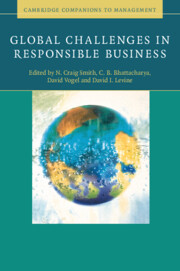Book contents
- Frontmatter
- Contents
- List of figures
- List of tables
- List of contributors
- Foreword
- Introduction: Corporate responsibility and global business
- Part I Embedding corporate responsibility
- Part II Marketing and corporate responsibility
- 5 Global segments of socially conscious consumers: do they exist?
- 6 Impact of CSR commitments and CSR communication on diverse stakeholders: the case of IKEA
- 7 The relationship between corporate responsibility and brand loyalty in retailing: the mediating role of trust
- Part III Corporate responsibility and developing countries
- Index
- References
7 - The relationship between corporate responsibility and brand loyalty in retailing: the mediating role of trust
Published online by Cambridge University Press: 05 June 2012
- Frontmatter
- Contents
- List of figures
- List of tables
- List of contributors
- Foreword
- Introduction: Corporate responsibility and global business
- Part I Embedding corporate responsibility
- Part II Marketing and corporate responsibility
- 5 Global segments of socially conscious consumers: do they exist?
- 6 Impact of CSR commitments and CSR communication on diverse stakeholders: the case of IKEA
- 7 The relationship between corporate responsibility and brand loyalty in retailing: the mediating role of trust
- Part III Corporate responsibility and developing countries
- Index
- References
Summary
While the history of empirical research about the relationship between the social and the financial performance of companies has been studied for years, the literature still lacks, according to many, a convincing proof that corporate social responsibility (CSR) adds to the bottom line. J.D. Margolis and J.P. Walsh emphasized that numerous empirical studies conducted in the last thirty years on the relationship between the social and financial performance of firms present serious methodological problems (in sampling, accurate measurement of social performance, absence of intermediate variables, absence of tests for the direction of the causal link). S.A. Waddock and S.B. Graves had already pointed out that research on social and financial performance was replete with difficult obstacles:
(1) Social performance is hard to measure directly; proxy measures, such as social expenses, are more observable but are not necessarily desirable antecedents of social performance.
(2) The link between social and financial performance is mediated by many factors; this link could be embedded in a complex causal web in which the company's response to social issues comprise only part of the relevant considerations.
(3) The direction of the causal link cannot be easily assessed, because the most financially successful companies will always have resources to ‘waste’ on social investment, while companies in financial crisis will often be forced to curtail such investment.
- Type
- Chapter
- Information
- Global Challenges in Responsible Business , pp. 191 - 214Publisher: Cambridge University PressPrint publication year: 2010
References
- 3
- Cited by



